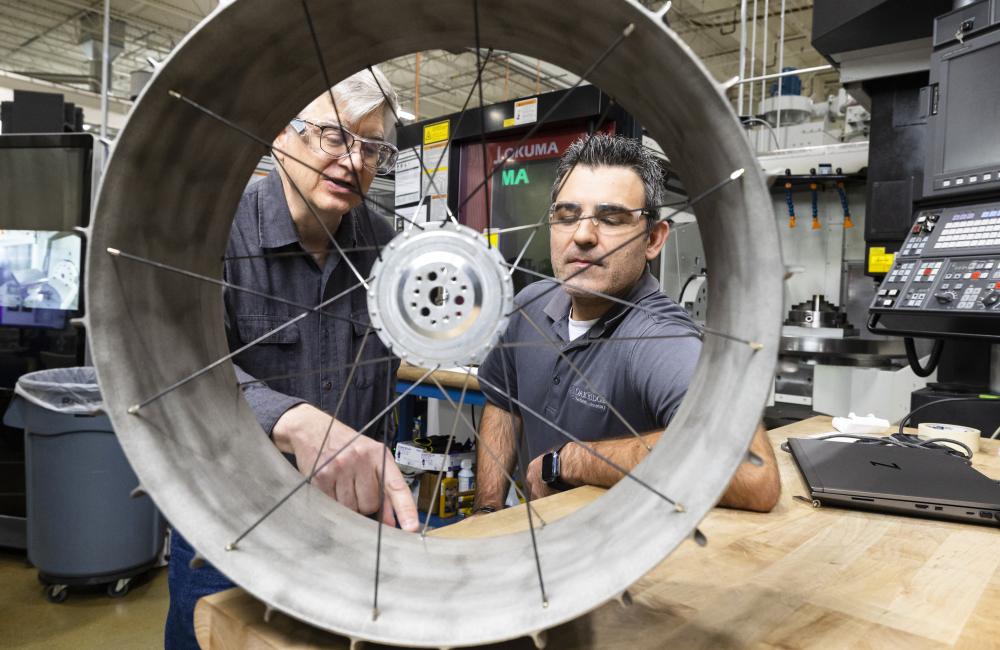

NASA mechanical design engineer Richard Hagen, left, and ORNL researcher Michael Borish inspect a lunar rover wheel prototype that was 3D printed at the Manufacturing Demonstration Facility. Credit: Carlos Jones/ORNL, U.S. Dept. of Energy
When you think about sending missions to the Moon, every single gram counts on launch day. Therefore, it makes sense to live off the land when you arrive with in-situ resource utilization. For example, what if you could fly a rover without wheels and 3D print them out of lunar regolith when you get there?
It just might happen.
Researchers used a 3D printer to build the same design for a wheel that will be part of the upcoming NASA VIPER rover. It was done using additive manufacturing (another word for 3D printing), melting metal powder and laying down and bonding a large number of successive thin layers of materials into the designed shape.
For doing this on the Moon, there are obvious challenges, like getting the raw metal from the lunar regolith to build the wheel and assembling the parts, but this is a first step.
While the prototype wheel printed at the US Department of Energy’s (DOE’s) Manufacturing Demonstration Facility, or MDF, at Oak Ridge National Laboratory will not actually be used on VIPER (Volatiles Investigating Polar Exploration Rover), it was created to meet the same design specifications as the wheels made for rover. Additional testing is planned to validate the design and fabrication method before using this technology for future lunar or Mars rovers or considering it for other space applications, such as large structural components.
But, say the researchers, the process demonstrates that the technology for creating specialized parts needed for space exploration is doable.
VIPER is a rover set to launch to the Moon in 2024 to map ice and other potential resources at the south pole of the Moon. The mission is intended to help determine the origin and distribution of the Moon’s water and whether enough could be collected from the Moon’s surface to support people living and working there.
As you can see, the design for the wheel is quite complex, with an intricate spoke pattern and spoke locking features for the wheel. But the team said that 3D-printing simplified and reduced the cost of the wheel design and made final assembly easier.
According to said Peter Wang, who led MDF demonstration, their 3D printer used a metal powder bed system. The machine rakes a layer of the nickel-based alloy powder over a stationary plate. Then a laser selectively melts a layer before the plate lowers slightly and the process repeats. They created a wheel about 20 cm (8 inches) wide and 50 cm (20 inches) in diameter – much larger than typical parts printed with metal powder bed systems. Making it required the ability to print small geometric features spread over a large work area.
“This dramatically increases the production rate with the same amount of laser power,” said Peter Wang in a press release. Wang leads MDF development of new laser powder bed fusion systems, and added that deposition occurs 50% faster. “We’re only scratching the surface of what the system can do. I really think this is going to be the future of laser powder bed printing, especially at large scale and in mass production.”
One challenge in using this system on the Moon, however, is that this 3D printer is large – similar in size to a cabinet big enough for a person to sit in. This big machine would have to be launched and landed on the Moon. But once there, it could build all sorts of items, given there are going to be the resources within the lunar regolith to create metals.
While that’s a lot of hurdles to overcome, creative thinking (and building) will be necessary for making a lunar base a reality.
The size of the 3D printer means it can create large objects.
The people working on this project – a collaboration between NASA and the DOE – said this demonstration with the prototype wheel demonstrates the value of interagency collaboration.
“The project with NASA really propelled the technology forward,” said Brian Gibson, the researcher who led the rover wheel project for ORNL, calling it a milestone. “It was great to connect a capability with a developing need, and the team was excited to be making a prototype component with space exploration applications.”
In 2015, the United Nations adopted the 2030 Agenda for Sustainable Development—the Sustainable Development Goals…
Astronomers have been battling threats to their clear skies on all fronts lately. One of…
If you were Captain of the first USS Enterprise, where would you go!? Humanity is…
Now is the best time to observe Mars in 2025. Mars from 2014. Credit: Paul…
Scheduled for launch in 2027, the Nancy Grace Roman Telescope is slowly being readied for…
Few places in the solar system are better suited to a balloon than Titan. The…